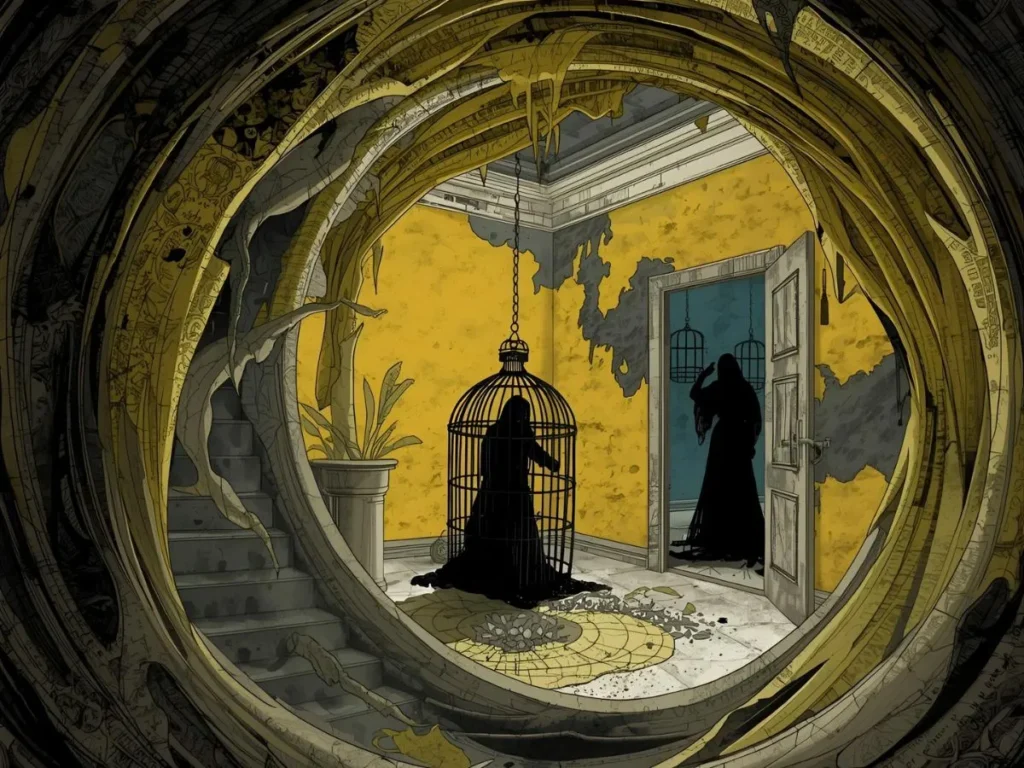“I lie here on this great immovable bed—it is nailed down, I believe—and follow that pattern about by the hour.”
Charlotte Perkins Gilman’s The Yellow Wallpaper may seem like just a story about a woman in a room, but if you look closer, the wallpaper whispers something much deeper—something painful, spiritual, and true.
Let me tell you a short story before we begin. I once knew someone who painted flowers on her bedroom walls.
She said it kept her from sinking into the dark thoughts. But over time, those flowers started to look wilted to her—twisted, even.
The same brushstrokes that once brought her peace, started to feel like a cage.
That’s exactly what happens in The Yellow Wallpaper.
The story isn’t just about a woman’s descent into madness. It’s about being silenced, ignored, and trapped inside the walls of expectation.
In this article, we’ll explore the deeper symbolism in The Yellow Wallpaper, so you can understand the spiritual and emotional truths hiding behind those yellow patterns.
Symbolism in The Yellow Wallpaper Quotes

Let’s look at the most symbolic and emotional quotes that reveal the deeper messages of the story:
“The color is repellent, almost revolting; a smouldering unclean yellow, strangely faded by the slow-turning sunlight.”
This isn’t just about color—it’s about decay, sickness, and the rot of suppressed emotions. Yellow often symbolizes sickness or caution. Here, it screams warning.
“There are things in that paper that nobody knows but me, or ever will.”
This shows the narrator’s growing connection with the wallpaper—and how it becomes a mirror of her inner turmoil.
“It is the same woman, I know, for she is always creeping, and most women do not creep by daylight.”
The woman behind the wallpaper becomes a symbol of every woman who has been trapped, hidden, and forced to suffer in silence.
“I pulled and she shook, I shook and she pulled, and before morning we had peeled off yards of that paper.”
Peeling the wallpaper becomes a symbolic act of breaking free—not just from a room, but from oppression.
These quotes show how Gilman uses simple visuals to uncover profound emotional and spiritual pain.
What Is the Symbolism in The Yellow Wallpaper?
The short answer: Everything is symbolic.
But let’s dig deeper.
At its heart, The Yellow Wallpaper is a spiritual cry for freedom. The symbolism touches on:
- Mental confinement: The room represents social cages women are placed in.
- Loss of identity: The narrator’s name is never revealed. This symbolizes how women often lost their sense of self in marriage and motherhood.
Spiritual symbolism often shows up in places we don’t expect—like a yellow wall. That’s what makes this story so powerful.
Examples of Symbolism in The Yellow Wallpaper

Here are some vivid examples of symbolism used to awaken emotion and spiritual reflection:
1. The Wallpaper
It’s ugly, it smells, and it traps something behind it. It’s a perfect symbol of repression—especially the repression of women’s emotions and desires.
2. The Woman Behind the Wallpaper
This is the spiritual double of the narrator. She represents every woman trying to escape society’s expectations.
3. The Room (Nursery)
A place for children becomes a prison for the narrator. Symbolically, it shows how women were treated like fragile children needing control—not grown individuals needing freedom.
4. The Windows
The windows symbolize hope, connection with the world, and longing for freedom. But the narrator can only look out—she’s not allowed to go out.
5. The Bed
It’s nailed to the floor. It symbolizes how sex, marriage, and control are all tied together in her life—immovable, inescapable.
Each of these examples adds another layer to the spiritual and emotional web of the story.
Wallpaper Symbolism in The Yellow Wallpaper
The wallpaper is the most powerful symbol in the entire story.
Here’s what it stands for:
- Mental illness: The twisting pattern is like the narrator’s thoughts—confusing, repetitive, and terrifying.
- Patriarchal control: It represents the way society locks women into roles and identities they didn’t choose.
- Spiritual unrest: The yellow color, the creeping figure, and the endless patterns reflect a soul crying out for recognition.
At first, the wallpaper is just ugly. But by the end, it’s a full-blown spiritual battleground.
Yellow Symbolism in The Yellow Wallpaper

This color holds layers of symbolic meaning:
- Decay: The wallpaper is a dirty, sickly yellow—like something rotting from the inside.
- Illness: Yellow has long been linked to jaundice and disease. Here, it symbolizes the invisible sickness of depression and trauma.
- Caution: Think of yellow caution tape. It warns us: “Something is wrong here.”
- Trapped light: Yellow is also the color of sunlight. But in this story, the light is twisted, unable to warm or heal.
Yellow is more than just a background color—it becomes a spiritual warning sign.
Symbolism in The Yellow Wallpaper Essay
If you’re writing or reading an essay on this topic, here are the core themes you should explore:
- Freedom vs. Oppression
The narrator wants to be heard, seen, and free—but society silences her. The wallpaper mirrors her struggle. - Mental Illness as Spiritual Imprisonment
Her breakdown isn’t random—it’s caused by being locked away, unheard. Her madness becomes a spiritual awakening. - The Role of Women in the 1800s
Women were expected to be silent, gentle, and obedient. The story symbolizes how those expectations can destroy the soul. - Symbolism as Resistance
Every object in the story—bed, window, wallpaper—becomes a tool to show how spiritual resistance rises from silent suffering.
If you see the wallpaper as just wallpaper, you miss the entire message. It’s a symbol of every unspoken pain.
Bed Symbolism in The Yellow Wallpaper

The bed is more than furniture—it’s a spiritual anchor.
Here’s what it represents:
- Imprisonment: The bed is nailed down. So is the narrator’s freedom.
- Sexual dominance: The narrator shares the room (and likely the bed) with her husband. It represents power imbalances in marriage.
- Motherhood and fatigue: Beds are where we rest, give birth, and sometimes feel our most trapped.
Even something as ordinary as a bed becomes a symbol of power and pain in this story.
What Is Symbolism in The Yellow Wallpaper? Real-Life 3 Short Scenarios
Sometimes, stories feel distant. So let’s bring the symbolism closer to real life.
1. A Woman at the Window
Imagine a woman looking out her apartment window every day, wishing she could leave an abusive relationship. She doesn’t speak about it, but her eyes say everything.
Symbolism: The window is her hope, her soul’s longing.
2. A Teenager Painting Over Her Walls
She paints over posters of flowers with black paint. Her mom thinks it’s a phase. But inside, she’s dealing with deep depression.
Symbolism: The paint is her silent scream.
3. A Stay-at-Home Dad
He loves his kids but feels invisible. He scrolls through social media, watching life pass by, locked in routine.
Symbolism: The phone is his only window to the outside world—and yet another cage.
These aren’t fiction. These are real lives—mirroring the narrator’s pain.
FAQs
1. Why is the wallpaper so important in the story?
Because it’s not just wallpaper—it’s a symbol of everything the narrator is feeling but cannot say out loud.
2. What does the woman behind the wallpaper represent?
She’s the narrator’s trapped spirit, but also represents all women who feel stuck, ignored, and unseen.
3. Is yellow always a bad color in symbolism?
Not always—but in this story, yellow becomes a symbol of sickness, warning, and spiritual decay.
4. How does the bed symbolize oppression?
It’s nailed down, like the narrator’s freedom. It also hints at sexual control and domestic imprisonment.
5. Was the author writing about herself?
Yes. Charlotte Perkins Gilman had a similar experience. This story is her spiritual testimony—and her way of warning others.
Conclusion:
The Yellow Wallpaper is more than a story. It’s a cry for help, a map of the soul, and a mirror for those who feel unseen.
By reading between the lines—and the patterns—you uncover a world of silent suffering, but also spiritual strength.
If you’ve ever felt trapped, overlooked, or like your voice didn’t matter—this story is for you.
Let the symbolism speak to your heart, and remind you that breaking free begins by being seen.




